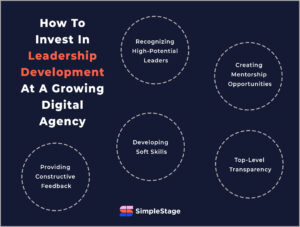
Growth in digital agencies is heavily dependent on the growth of individual employees and employee leadership development. Fostering growth amongst your most promising employees is one important move you can make to ensure the longevity of your agency.
When your current leadership steps down or when your business scales to the point you need more minds at the helm, having already invested in leadership development will mean you’re prepared to leap to the next step. Stockpiling great potential leaders is one move your company should be making behind the scenes.
You can begin fostering growth by:
- Identifying workers with potential
- Pairing senior members with developing leaders for mentorship
- Being transparent about strategy
- Emphasizing soft skills
- Offering helpful feedback
Why Is Leadership Development Important
A well-built agency will survive long past the tenure of its early leadership. Setting an agency up for longevity means preparing to leave it in capable, eager hands.
Investing in employees is the best way to teach them to be the capable future leaders your agency will need and acts as a future-proofing survival mechanism in your company.
There are several steps to follow that will increase your employee leadership development practices. These include:
1. Recognizing High-Potential Leaders
How do you identify a high-potential leader amongst your team? When it comes to implementing leadership development, spotting workers with potential is essential within your digital agency. But who makes a good leader?
Future good leaders are those who are already taking on challenges in their day-to-day tasks. You’ll see them absorbed by their work and balancing multiple aspects well.
Those with potential are also good team members. They communicate with others and motivate their team from within.
Perhaps most promising is the fact that they take on work without being asked. They always want to do more and understand more about a challenge, enhancing everyone’s experience during a project and bringing more to the table than was asked for.
2. Creating Mentorship Opportunities
Fostering opportunities for potential leaders to learn from the best is a clear and obvious way for them to get to know the ins and outs of higher-level management in the agency. Setting up a workplace mentoring program is an excellent way to do this.
Think about what you want your mentees to get out of the process. How can you build them up as leaders while learning from present leadership? Detail a few specific ways they can learn within your agency.
Brainstorm some ideas about how the program will run. Can anyone be mentored, or are you limiting it to your previously identified high-potential leaders? How will you choose mentors from among your current leaders?
Once you map out mentorship goals, begin enrolling mentors and mentees and introduce ideas for them to work together on.
3. Top-Level Transparency
How will future leaders know how to lead the agency if they aren’t exposed to strategy now? Being transparent about top-level strategy with potential leaders is essential to teaching them the structure and processes of leadership within your agency.
Strategy is something they will need to learn over years. Regular exposure to the thought process behind certain strategies, execution, and results of said plans will help future leaders become equipped for taking over someday.
4. Developing Soft Skills
Soft skills are the grease on the track that keeps things moving. Your future leaders may be learning to be supervisors and managers, which means they will be working directly over other workers. Soft skills are the interpersonal skills needed to make these relationships function better.
Tone of voice is one soft skill leaders often need to work on. Keeping impatience, frustration, and anger out of their voices during difficult conversations creates a safe space for their workers to bring problems to them. Using an understanding tone when mistakes have been made can help facilitate improvement on behalf of grateful employees who expected to be met with admonishment.
Written communication is another soft skill leaders need to nail down. Workers who tend to over-explain issues in novel-length emails can learn how to shorten up their messages to just the salient points for clearer communication with co-workers and team members.
5. Providing Constructive Feedback
Some day your potential leaders will have to give out constructive feedback or deal with negative client feedback. The best way for them to learn how to do so is by example: receiving constructive criticism now. They will remember the ways you present this feedback, good or bad, so make sure to do it in an effective manner.
A popular feedback technique is the sandwich method. Whenever providing constructive criticism, it can be helpful to sandwich whatever needs to be improved between two elements of positive feedback.
For example, “This report came out great. Next time, it might be better to get it in a few hours before the meeting for review. But you really highlighted the numbers we needed to see here.”
Looking for a way to improve the way your agency collaborates with clients and stakeholders?
SimpleStage is the only platform that unifies the client experience by providing tools to help agencies collect content, feedback and track bugs.
Learn MoreRetaining Good Leadership
The last thing you want to do after investing in employees for leadership development is to lose them to another company primed to promote faster. When you begin your leadership development process, be open with your employee about the path you are starting and your hopes for them within the company.
Be reasonably transparent about a timeline. Staying with the hopes of imminent leadership opportunities is likely more attractive than applying for other positions.
Retain excellent potential in your company by giving those you are developing as leaders internal opportunities, such as mentoring and strategy participation, to keep them engaged and on track for when it’s time to turn potential into actual leadership. Invest in your people to invest in your agency’s future.

